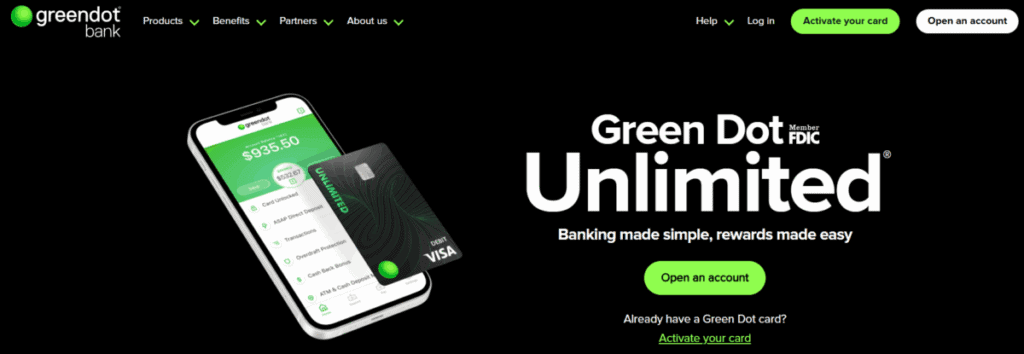
Green Dot Review
- 11th Jun, 2025
- | By Linda Mae
- | Reviews
Green Dot Corporation is a financial technology and bank holding company that has grown into one of the leading providers of prepaid debit cards and banking services in the United States. Founded in 1999, the company initially focused on prepaid cards sold through retail outlets, targeting consumers who didn’t have access to traditional bank accounts. Over time, Green Dot expanded its offerings to include mobile banking, direct deposit features, and even personal banking services through its own FDIC-insured institution, Green Dot Bank. Lets read more about Green Dot Review.
The company’s goal is to make modern banking more affordable and accessible, especially for low-income and underbanked communities. Green Dot has a significant presence in both urban and rural areas thanks to its partnerships with major retailers like Walmart, Walgreens, CVS, and Rite Aid, which make its services widely accessible.
Despite its popularity, Green Dot has received mixed feedback over the years. Some users appreciate the convenience and accessibility, while others raise concerns about customer service, unexpected fees, and account limitations. These contrasting experiences make Green Dot a brand worth examining closely, especially for those seeking an alternative to traditional checking accounts or who need a simple, reloadable payment option.
Account Types and Accessibility | Green Dot Review
Green Dot offers several financial products tailored to different banking needs. The core offering is its prepaid debit card, which allows users to load funds and use it for purchases just like a traditional debit card. In addition, Green Dot provides full-featured mobile bank accounts with checking-like capabilities, savings options, and even high-yield savings accounts in select cases.
Accessibility is one of Green Dot’s greatest advantages. You can open an account online or buy a starter kit from more than 90,000 retail locations nationwide. Those who do not have easy access to physical banks will find this convenience appealing. Opening an account is made simpler for people with bad credit or little banking history because no credit checks are needed to get started.
Green Dot also caters to government benefits recipients and gig economy workers by offering services like direct deposit, early paycheck access, and tax refund deposits. For people who need a simple banking solution without the formality and barriers of traditional banks, Green Dot is easy to access and use.
However, accessibility sometimes comes with trade-offs. While the brand promotes financial inclusion, not all account features are as robust or reliable as those offered by larger banks or newer fintech rivals. Still, for many users, especially those looking for a low-barrier entry into digital banking, Green Dot offers a valid alternative.
Mobile App Experience and Online Features
The Green Dot mobile app is designed to give users full control of their account from their smartphone. Available on both Android and iOS, the app provides features such as checking balances, tracking transactions, paying bills, depositing checks remotely, and managing direct deposits. The app is relatively easy to navigate, making it approachable for new users, even those not deeply familiar with mobile banking.
One feature that stands out is mobile check deposit, which allows users to upload photos of checks and deposit funds without visiting a store. Additionally, users can instantly send money to other Green Dot customers, which adds convenience for friends and family who also use the service. Bill pay options within the app also allow for scheduling and tracking recurring payments.
Despite having the majority of the necessary banking features, the app’s dependability and performance have drawn mixed reviews. While some users have complained about problems like app crashes, sluggish customer support integration, and delayed transaction posting, others have reported seamless, easy experiences. These discrepancies can be frustrating, particularly when dealing with transactions or payments that have a deadline.
The online portal mirrors many of the app’s functions, but mobile access is the primary way users interact with their accounts. In a competitive fintech space, Green Dot’s app holds its own, though it may lag behind some of the more polished offerings from newer digital-first banks.
Fees, Charges, and Transparency
Understanding Green Dot’s fee structure is essential before signing up. While the company promotes convenience and ease of access, it comes with a range of fees that may catch users off guard. For example, many Green Dot prepaid cards have a monthly maintenance fee that applies unless certain conditions are met, such as maintaining a minimum balance or setting up qualifying direct deposits.
There are also charges for services like ATM withdrawals, balance inquiries, and reloading funds via cash at retail locations. Some accounts include overdraft protection features, but these often involve additional fees after a grace period or specific usage terms. Reloading at third-party retailers typically includes service charges that vary depending on the location and method.
Green Dot does provide a fee schedule on its website and with product packaging, but users have frequently complained that the information is not always clear or easy to find. Additionally, fee waivers are often dependent on account activity that may not be intuitive for all users.
The fees may be affordable for users who fulfil the usage requirements. Unexpected charges, however, can rapidly deplete account balances for people who are not familiar with the fine print. Green Dot’s fee structure might benefit from more understandable explanations and simpler terminology for the typical consumer. Transparency and upfront communication are crucial in the fintech industry.
Direct Deposit and Early Pay Access
One of Green Dot’s most promoted features is the ability to receive paychecks or government benefits via direct deposit up to two days early. This can be a major advantage for individuals living paycheck to paycheck or those with tight budgeting needs. The early deposit feature is available for payroll, government benefits, and tax refunds.
Setting up direct deposit is relatively easy. Users receive a Green Dot routing and account number that they can provide to their employer or benefits provider. Once deposits are verified, funds may appear earlier than with traditional banks, depending on the sender’s payment processing schedule. The benefit of early pay access can provide a cushion and flexibility for financial planning, especially during emergencies. However, the actual timing may vary based on how quickly the payer processes the transfer. Green Dot does not guarantee early access on every deposit, and delays can occasionally occur.
While early direct deposit is a valuable service, some users have complained about inconsistencies in timely fund transfers. It’s possible that these experiences are caused by outside forces beyond Green Dot’s control, but uncertainty can be frustrating. Green Dot is appealing to users who require faster access to their money because of this feature, but it should be used with the understanding that timing is not always guaranteed.
Reload Options and Cash Deposit Convenience
Green Dot offers multiple ways to add funds to an account, which adds flexibility for users who rely on cash or other payment sources. The most popular method is using retail partners such as Walmart, CVS, or Walgreens to reload the card with cash. Users simply bring their card and payment to the cashier, and the amount is added to their Green Dot account.
Other methods include direct deposit, mobile check deposit, and bank transfers. These options make Green Dot suitable for users with diverse income sources, whether from employers, freelance gigs, or government benefits. Some Green Dot accounts also allow users to link external bank accounts for more seamless transfers.
While the variety of funding methods is a strength, the fees associated with them can be a drawback. For example, cash reloads at retailers often involve service fees set by the merchant, which may add several dollars per transaction. These fees can add up, especially for users who make frequent deposits.
Another thing to keep in mind is that, depending on the location and time of day, cash reloads may take some time to appear in the account. Although Green Dot offers guidance and assistance for reloading, the procedure might seem laborious in contrast to banks that accept mobile deposits or electronic payments without charging additional fees.
Despite these limitations, the multiple reload options still make Green Dot practical for users without regular access to online banking or traditional financial tools.
Security Features and Customer Support
Green Dot accounts are backed by Green Dot Bank, a member of the FDIC, which means eligible deposits are insured up to standard limits. This gives users confidence in the safety of their funds. The company also uses encryption and secure login features to protect sensitive account information on both the app and online platforms.
Security measures include real-time transaction alerts, the ability to lock and unlock the card, and fraud monitoring services that detect unusual activity. These features provide essential protections, particularly for users managing their accounts entirely through mobile devices.
However, security is only one side of the user experience. Customer support is another area where Green Dot has received mixed reviews. While there is a help center on the website and automated phone lines, users often report long wait times and difficulty reaching a live representative. Email support is available, but response times can vary widely.
Sometimes, disputes over blocked accounts, unauthorised charges, or payment delays cause a great deal of annoyance for users. Users who depend on the account for daily expenses may find this to be particularly stressful. To sum up, Green Dot provides respectable security infrastructure, but its customer support occasionally falls short of user expectations. The user experience would be greatly improved by more reliable and responsive support channels for a financial service targeted at high-volume consumer use.
Limitations and User Complaints
No financial service is perfect, and Green Dot is no exception. While the company serves a wide range of customers, it has also attracted criticism, particularly around customer service, transaction issues, and sudden account freezes. These complaints often appear in app store reviews, online forums, and consumer feedback platforms.
A recurring theme is account access problems. Users have reported being locked out of their accounts with limited explanation, often during critical moments such as receiving a paycheck or accessing emergency funds. Resolving such issues through customer support has sometimes proven difficult or time-consuming.
Another limitation involves the fee structure. While Green Dot promotes itself as an accessible and low-barrier option, users have been caught off guard by fees for inactivity, cash reloads, or monthly service charges. For those not carefully tracking usage conditions, costs can build up unexpectedly.
Additionally, a few users have reported irregular direct deposit timing and delayed mobile cheque deposits. Even though third-party processing might be the cause of these delays, the lack of transparency undermines confidence. These issues point to the need for improved communication and a more user-friendly interface, but they do not imply that Green Dot is inherently unreliable. If reliable service and prompt support are important to potential clients, they should take these restrictions into account and weigh their options.
Comparisons with Similar Providers
Green Dot operates in a highly competitive market that includes other prepaid and digital banking options. Notable alternatives include Netspend, Chime, and Bluebird by American Express. Each of these providers targets similar user segments but takes a slightly different approach.
Compared to Netspend, Green Dot offers a broader retail presence and slightly more traditional banking features. However, Netspend may have more customizable account options, especially for budgeting tools. Chime, on the other hand, is often praised for its sleek app experience, low fees, and modern customer engagement. Chime also tends to have more transparent terms and a stronger reputation for direct deposit reliability.
Bluebird, offered in partnership with Walmart, competes closely with Green Dot in the prepaid card space. It offers lower fees in many areas and provides additional budgeting tools, though it may not have the same brand recognition outside of Walmart customers.
Strong accessibility and a well-established retail network help Green Dot maintain its position. Its pricing and customer service, however, are inferior to those of its more recent fintech rivals. Green Dot is still a good option for consumers who require physical access to cash loading and a large network of retailers. Alternatives may offer better value for those seeking advanced budgeting tools, robust mobile experiences, or improved fee transparency.
Final Verdict: Who Should Use Green Dot?
Green Dot is a convenient option for users needing simple, accessible banking without a traditional bank. It’s ideal for the underbanked, offering easy setup, retail availability, and flexible deposits. However, users should watch out for fees and inconsistent service. Best used as a secondary or transitional financial tool.
FAQs
Q1: Is Green Dot a real bank or just a prepaid card?
Green Dot offers both prepaid cards and bank accounts. It operates as a legitimate financial institution through Green Dot Bank, which is a member of the FDIC.
Q2: How can I avoid Green Dot’s monthly fees?
Many Green Dot accounts waive the monthly fee if you meet conditions like setting up qualifying direct deposit or maintaining a minimum balance. It’s important to check the specific terms for your product.
Q3: Can I use Green Dot as my primary bank?
You can use Green Dot as a primary banking option, but you may face limitations with customer service, deposit timing, and advanced financial features compared to traditional banks or newer digital banks.



